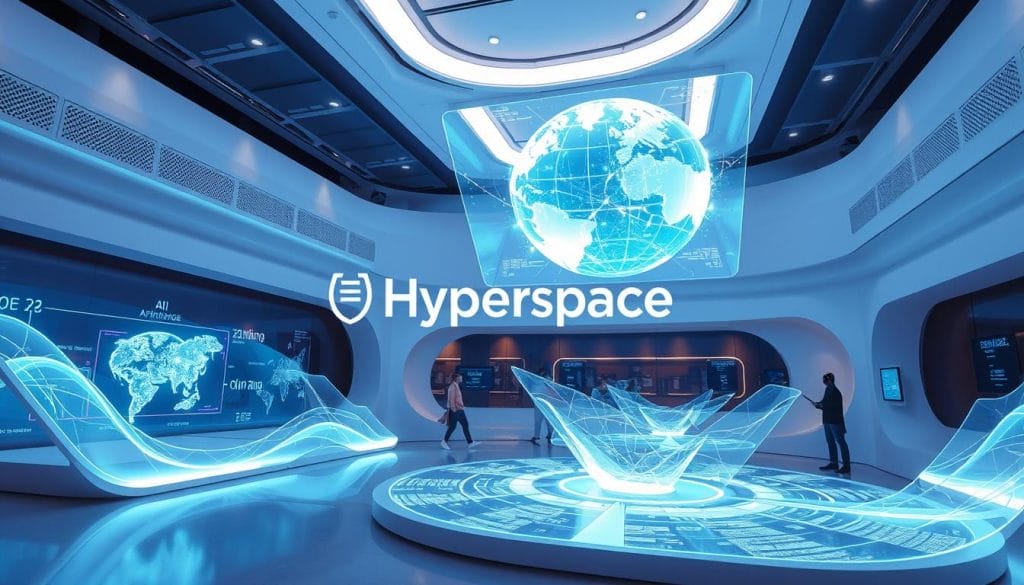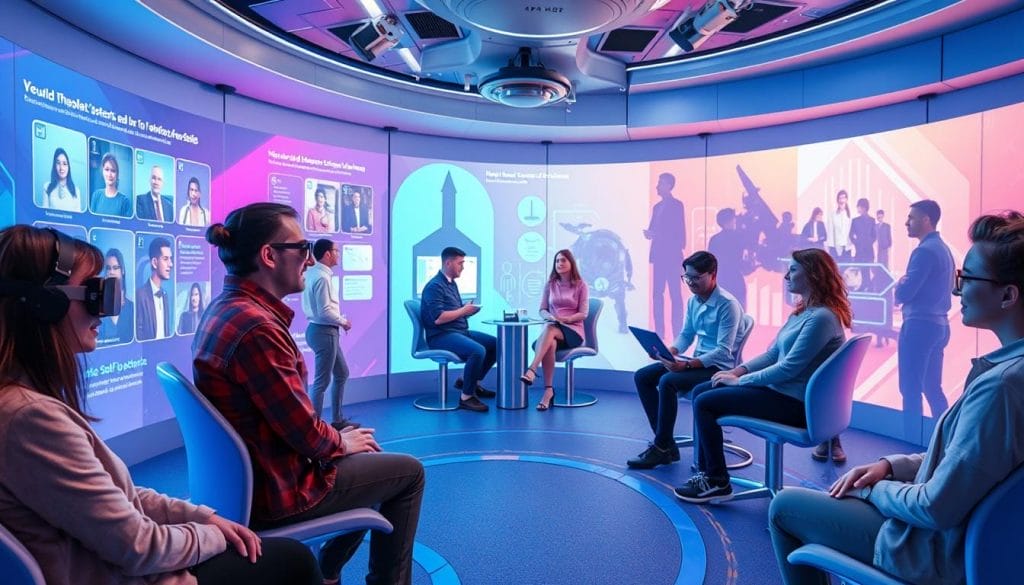In today’s fast-changing business world, soft skills are key to success. Companies know that skills like communication, problem-solving, and adaptability are vital. But, old ways of teaching these skills have their limits.
They struggle to offer personalized learning, grow with big companies, and show how well training works.
Hyperspace, a top name in AI solutions, brings a new way to learn soft skills with AI-powered 3D simulations. These platforms use immersive and adaptive learning to change how companies train their teams.
Hyperspace uses advanced AI to make virtual scenarios that feel real. Employees can practice, get feedback, and improve their soft skills. These simulations work well with current learning systems, making training better and more data-driven.
Key Takeaways
- AI-powered 3D simulations change soft skills training with interactive, personalized learning.
- Companies can use these new tools to improve employee skills and stay ahead.
- Hyperspace’s platforms have cool features like AI avatars, gesture adaptation, and work with LMS for assessments.
- AI-driven training solves big problems of old methods, like growing and measuring success.
- Immersive learning and feedback help develop skills and keep knowledge strong.
Introduction to AI-Powered Simulations

Organizations are now using new technologies to improve their employees’ soft skills. They are turning to AI-powered simulations in digital training programs. These simulations use artificial intelligence to offer personalized learning experiences for each learner.
What are AI-Powered Simulations?
AI-powered simulations are virtual environments that use machine learning. They analyze how users behave and learn, then give feedback and guidance. This makes learning more engaging and personal than traditional methods.
Importance of Soft Skills in the Workplace
Soft skills like communication and problem-solving are key in today’s workplace. They help build strong relationships and solve conflicts. As the job market demands more adaptable workers, training in these skills is becoming more important.
The need for better training methods has grown. This includes interactive soft skills development, digital employee training, and gamified corporate training. AI-powered simulations are changing the game, making learning more immersive and effective.
“The future of learning and development lies in the seamless integration of AI and immersive technologies, creating personalized, adaptive, and engaging training experiences that empower employees to reach their full potentia.”
Benefits of 3D Simulations for Soft Skills Training

3D simulations are changing how companies train for soft skills. These computer-generated training scenarios and artificial intelligence-driven simulations bring many benefits. They outdo traditional methods in many ways.
Immersive Learning Experience
3D simulations use VR and AR to create a deep learning experience. A PwC survey found 30% of companies now use VR in their training. They see how powerful this technology is.
Enhanced Retention of Information
VR training boosts soft skills scores by 44% compared to old methods. Also, 95% of people feel safer at work after XR training. They learn 230% more than with traditional methods.
Realistic Scenarios for Practical Application
These simulations mimic real-life situations. Learners practice important soft skills safely. They gain 275% more confidence than in classroom training, and 35% more than with e-learning.
3D simulations offer a safe, engaging, and effective way to train. They’re changing how companies improve their workforce’s soft skills. This technology is set to shape the future of learning and development.
Key Features of AI-Powered 3D Simulations
AI-driven 3D simulations change how companies train their employees. They offer unique features that make learning fun, tailored, and effective. These platforms are key to improving soft skills in the workplace.
Adaptive Learning Pathways
AI-powered 3D simulations have adaptive learning pathways. They use smart algorithms to adjust the training based on how well you’re doing. This means each person gets a learning plan that fits their level and needs.
These platforms make sure you learn and grow by adapting to your progress. This approach helps you keep what you learn and improve your skills.
Virtual Reality Integration
Many of these simulations use virtual reality (VR) to create real-life environments. This lets employees practice their skills in a safe, realistic way. They can work on communication, decision-making, and problem-solving in a more engaging setting.
Real-Time Feedback Mechanisms
Real-time feedback is a key part of these simulations. They use advanced tech to give instant, personalized advice. As you go through the scenarios, you get feedback on your actions and skills right away.
This feedback helps you see where you need to improve. It lets you adjust your approach on the spot. AI-powered 3D simulations are changing how companies train their teams. They make learning more fun, tailored, and effective than ever.
How Enterprises Can Implement This Technology
Enterprises looking to boost their soft skills training can use AI-powered 3D simulations. First, they need to figure out what skills are lacking. This helps tailor the training to focus on the most important areas.
Choosing the right platform is key. Look for customization, scalability, and easy integration with current programs. Virti, for example, makes it easy for anyone to create engaging lessons and track progress.
Combining AI-powered 3D simulations with traditional training is vital. This mix can greatly improve the development of essential soft skills in the workforce.
| Key Considerations for Implementing AI-Powered 3D Simulations |
|---|
|
By carefully considering these factors, enterprises can successfully implement AI-powered 3D simulations. This can revolutionize their soft skills training programs and empower their workforce for the digital age.
“VR training for soft skills such as public speaking, negotiation, and networking is being increasingly adopted as these skills are considered vital requirements in new candidates and employees.”
Case Studies: Success Stories from Leading Companies
Companies from different fields have used AI-powered 3D simulations to change their training. These new virtual reality and interactive training methods are showing great results. They help employees get better at talking, working together, and making decisions.
Company A: Transforming Communication Skills
Northeast Georgia Health System and Graduate Medical Education teamed up with Virti. They created new 360 virtual reality diversity and inclusion learning platforms. This training helped healthcare workers improve their communication skills, like listening and solving problems.
Thanks to this program, healthcare providers are now better at talking to patients. This has led to stronger patient-doctor relationships and better care overall.
Company B: Enhancing Team Collaboration
Maudsley Learning, a top mental health education provider, used Virti’s platform. They made simulation training for mental health scenarios. This AI-powered method was the core of their “Champions” program.
This program helped big companies improve teamwork and problem-solving. Employees felt more confident and could handle conflicts better. They also worked better in teams.
These stories from top companies show how AI-powered 3D simulations can change training. They make virtual reality training and interactive soft skills development better. By using this tech, companies are helping their teams do well in today’s fast-changing world.
“VR training has been a game-changer for our customer service team. The immersive scenarios allowed our employees to practice difficult conversations and build empathy, leading to a significant improvement in client satisfaction.”
– Jane Doe, Customer Service Manager, Bank of America
Customization Options for Enterprises
Enterprises looking to add gamified corporate training and focused training can find great options. AI-powered 3D simulations offer a wide range of customization. This lets companies make training fit their culture, challenges, and goals.
Tailoring Scenarios to Fit Company Culture
Customizing training scenarios makes sure it’s relevant to employees’ daily work. This personal touch boosts the training’s impact. It also strengthens the connection between the learning and the company’s values.
Including Specific Challenges and Goals
Adding specific challenges and goals to 3D simulations makes training more effective. It prepares employees for real-world situations. This customization makes the training more relevant and effective.
“80% of managers reported they or their team were likely to engage with gamified cloud training in the next year.”
Platforms like Virti make it easy to create and update interactive content. This allows companies to quickly adapt their training. It helps them stay ahead and provide the best training experiences.
Overcoming Challenges in Soft Skills Training
Traditional soft skills training has been a key part of corporate life for a long time. But, it faces big challenges like lack of personal touch, scaling issues, and measuring success. AI-powered 3D simulations are changing how we train for soft skills in the workplace.
Common Obstacles in Traditional Training
Traditional training often treats everyone the same, which doesn’t work for everyone. People learn differently and have unique needs. It’s hard for standard programs to meet these needs.
Scalability is another big problem. In-person training and role-playing are hard to do for big teams spread out over long distances.
It’s also tough to show how soft skills training works. You can’t just measure it like technical skills. This makes it hard to prove the value of training to the company.
Addressing Resistance to Change
To get people to try AI-powered 3D simulations, show them the benefits. Explain how it offers personalized, scalable, and measurable training. This can win over the team.
Also, talk about how 3D simulations are fun and engaging. They help people learn better and remember more. And, let employees practice in a safe space to get feedback right away. This makes the switch to new training methods easier.
By tackling the problems of old training methods and showing the power of AI, companies can start a new chapter in training. They can prepare their teams for the digital world’s changing needs.
Measuring the Effectiveness of Training Programs
It’s key to check how well AI-powered 3D simulations work for soft skills training. By looking at important performance signs, companies can see how good their training is. This helps them make better choices to improve learning.
Key Performance Indicators (KPIs)
Important KPIs for checking training success include:
- Skill improvement rates: See how much better employees get at skills like talking, working together, and making decisions after training.
- Completion times: Find out how long it takes for people to finish the simulations and use what they learned in real life.
- Application of learned skills: See if employees can really use what they learned in their jobs.
Gathering Feedback from Participants
Getting feedback from those who took the training is also very important. Tools like Virti help measure how well people learn and how the training affects them. This feedback can come from:
- Surveys: Ask employees about their experience, how they feel about their skill growth, and what they think could be better.
- Interviews: Talk one-on-one or in groups to really understand what learners think and how they use what they learned.
- Performance assessments: Check how well trainees do in simulated situations and compare it to before they trained.
By looking at KPIs and feedback, companies can make their AI-powered 3D simulation training better. This ensures it meets the changing soft skills needs of their workers.
| KPI | Metric | Benefit |
|---|---|---|
| Skill Improvement Rates | Percentage increase in soft skills proficiency | Measures the impact of training on employee capabilities |
| Completion Times | Average time to complete simulations | Evaluates the efficiency and user-friendliness of the training program |
| Application of Learned Skills | Frequency of skills application in real-world scenarios | Assesses the practical relevance and transferability of training |
“Employees learn four times faster with VR training compared to traditional methods.”
Future Trends in AI and Simulation Training
The future of AI in 3D simulations for soft skills training looks bright. Machine learning is making these tools more adaptable and effective. We’ll see more ways to mix virtual and real-world learning, changing how companies train their teams.
The Role of Machine Learning
Machine learning is key to AI simulations. It lets them adjust to each learner’s needs for a more personal training. As these algorithms get better, simulations will feel more real and interactive, making learning more effective.
Expansion into Other Training Areas
AI-powered 3D simulations are mainly used for soft skills now. But they could soon be used for other types of training too. This includes technical skills, compliance training, and training for specific industries.
With more advanced AI, like natural language processing and emotion recognition, simulations will get even better. Trainees will have more realistic and natural interactions. This will help them better apply what they learn in real situations.
“AI simulations allow employees to practice realistic-seeming interactions in a safe environment, helping them desensitize to anxiety and gain confidence in handling real-life scenarios.”
As AI technology improves, we’ll see more personalized learning experiences. AI simulations will be tailored to each person’s needs and preferences. This will make training more effective and engaging for employees.
The future of AI and simulation training is full of possibilities for companies. By using these new technologies, businesses can build a skilled and adaptable workforce. This will help them stay competitive in a fast-changing market.
Cost Considerations for Implementation
Using AI for soft skills training in businesses needs a good budget plan. The start-up costs might be more than old training ways. But, the long-term gains are often worth it. Companies should think about hardware, software, content, and upkeep costs when setting up AI training.
Budgeting for AI-Powered Training Solutions
Small AI projects in 2024 cost between $10,000 and $50,000. Mid-scale ones are $50,000 to $200,000. Big AI projects can go over $200,000. But, remember, extra costs like data care, storage, and updates can add 10-20% each year.
Return on Investment (ROI) Assessment
When looking at AI’s ROI for soft skills, think about better learning, more engaged employees, and less training time. These solutions can also save money with reusable content. Businesses will see better training, more engaged people, and a better employer image.
| Cost Factor | Typical Cost Range |
|---|---|
| Small-scale AI Projects (2024) | $10,000 – $50,000 |
| Mid-scale AI Projects | $50,000 – $200,000 |
| Enterprise-grade AI Projects | $200,000+ |
| Hidden and Ongoing Costs | 10-20% of initial cost per year |
By looking at costs and gains, companies can decide wisely on AI for soft skills training.
Conclusion: The Future of Soft Skills Training in Enterprises
The future of soft skills training in businesses is bright with AI-powered 3D simulations. These tools offer personalized, engaging, and effective learning. They meet the changing needs of today’s workforce. As competition grows and technology advances, investing in advanced training is key to staying ahead.
Embracing Technology for Workforce Development
AI-powered 3D simulations create immersive learning spaces. They improve knowledge retention and practical skills. These solutions adapt to each learner’s needs, making training more inclusive and effective.
A Call to Action for Businesses
Businesses should explore and use AI-driven solutions for training. They have the power to change workplace learning and boost success in the digital world. By using AI-powered 3D simulations, companies can empower their teams, develop essential skills, and overcome new challenges.
FAQ
Q: What are AI-powered 3D simulations for soft skills training?
A: AI-powered 3D simulations use artificial intelligence and virtual reality. They create immersive learning environments for soft skills. These simulations are interactive and personalized, improving employee learning and engagement.
Q: Why are soft skills important in the workplace?
A: Soft skills like communication and problem-solving are key in today’s workplace. They help build strong relationships and solve conflicts. They are essential for a positive work environment.
Q: What are the benefits of using 3D simulations for soft skills training?
A: 3D simulations offer immersive learning experiences. They enhance engagement and information retention. Learners practice in safe environments and score higher on soft skills assessments.
Q: What key features do AI-powered 3D simulations offer?
A: These simulations have adaptive learning pathways. They adjust to individual learner needs. They also include virtual reality, real-time feedback, and natural language processing for realistic interactions.
Q: How can enterprises implement AI-powered 3D simulations for soft skills training?
A: First, assess your training needs and identify skill gaps. Choose the right simulation platform based on customization, scalability, and integration. Ensure seamless integration with existing training programs.
Q: Can you provide examples of companies that have successfully implemented AI-powered 3D simulations?
A: Yes, companies like Northeast Georgia Health System and Maudsley Learning have seen success. Their case studies show how this technology improves communication and team collaboration.
Q: How can enterprises customize the AI-powered 3D simulations?
A: Tailor scenarios to fit your culture and industry challenges. This ensures the training is relevant and applicable to employees’ daily work. Platforms like Virti make it easy to create and update content.
Q: How can enterprises overcome resistance to adopting AI-powered 3D simulations?
A: Highlight the benefits of AI-driven training, like increased engagement and performance. Show how it provides safe practice environments and immediate feedback to gain employee support.
Q: How can enterprises measure the effectiveness of their AI-powered 3D simulation training programs?
A: Track KPIs like skill improvement rates and completion times. AI-driven analytics provide insights into learner progress. Feedback from participants helps refine the training program.
Q: What is the future of AI-powered 3D simulations in soft skills training?
A: The future looks promising with ongoing advancements in machine learning. These tools will become even more adaptable and effective. They may also be used for technical skills and compliance training.
Q: What are the cost considerations for implementing AI-powered 3D simulations?
A: Initial costs may be higher, but the long-term benefits are worth it. Consider hardware, software, content development, and maintenance costs. Assess ROI based on improved learning outcomes and employee engagement.





